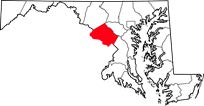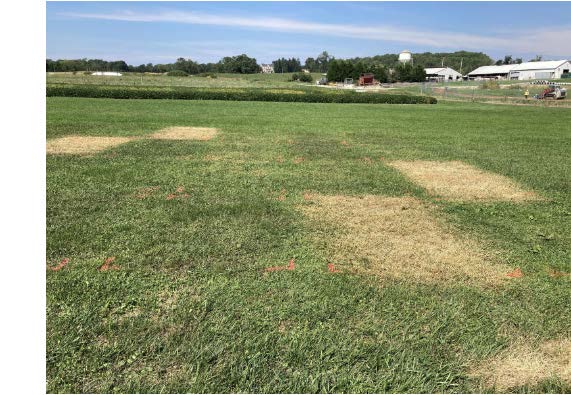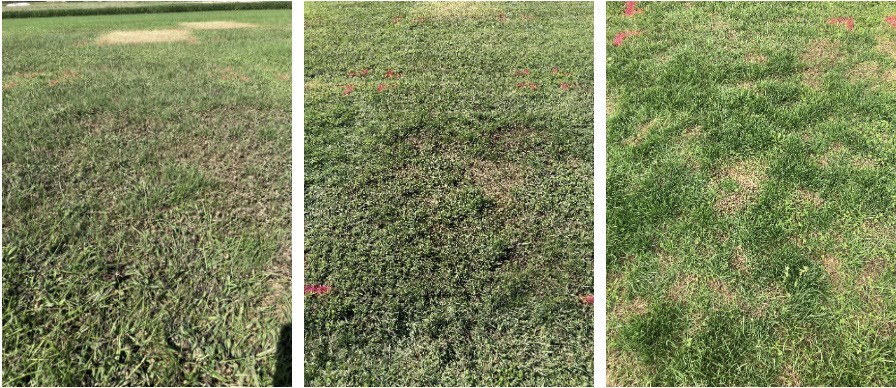Efficacy of Organic Turf and Landscape Herbicides in Montgomery County, Maryland
Kelly Nichols | kellyn@umd.edu | University of Maryland Extension

Background
In 2019, a law went into effect in Montgomery County in central Maryland which prohibited the use of synthetic pesticides on home lawns. In order to provide additional information to the lawn care industry in the county, a preliminary study was conducted in the fall of 2022 to compare the efficacy of a few organic herbicides.
Methods
Study Design
Five organic treatments were included, along with one synthetic treatment for comparison (Table 1). Treatments were placed in a randomized complete block design with four replications. Individual plots measured 1.5 m by 2.4 m. The plot area consisted of strips of turf species established in 2009. Each replication of the current study was placed within one of these strips. Turf species in the strips were Kentucky bluegrass (Poa pratensis L.) + perennial ryegrass (Lolium perenne L.); tall fescue [Lolium arundinaceum (Schreb.)] + Texas bluegrass (Poa arachnifera); tall fescue + Kentucky bluegrass; and creeping red fescue (Festuca rubra) + annual ryegrass (Lolium multiflorum) + perennial ryegrass + intermediate ryegrass (Lolium hybridum) + Kentucky bluegrass.
Table 1. Treatment list.


Applications & Data Collection
The first application was made on September 16, 2022. A second application of the organic herbicides was made four weeks later on October 14, 2022. Dandelion (Taraxacum officinale F.H. Wigg) and buckhorn plantain (Plantago lanceolata L.) were the two most prevalent weeds. Weed counts were taken three days before the first application and two weeks after the second application (beginning and end of study). Visual ratings were taken three days after each application as well as weekly up to one week after the second application.
Results
Buckhorn Plantain
The organic herbicides provided 20% or less control of buckhorn plantain throughout the study.
Dandelion
The middle and high rates of FeHEDTA provided 71 and 86% control, respectively, of dandelion at three days after the first application (3 DAT; Figure 2). However, this quickly dropped to 3 and 35% at one week after the first application (1WAT). At three days after the second application (3DAT2), all rates of FeHEDTA provided significantly similar control (61-99%). At one week after the second application, all rates of FeHEDTA, along with the synthetic treatment, provided significantly similar control (65-99%).
Figure 3. Dandelion control data. 
The same letters within an application timing are not significant using Tukey-Kramer HSD at P<0.05. Only one letter was added when data points were clustered together.. (For example, at 1WAT, all ratings below the letter "B" have the Letter "B".)
 Figure 4. Pictures of the FeHEDTA high rate plots three days after the first application (3DAT), one week after the first application (1WAT), and at the end of the study (two weeks after the second application, 2WAT2).
Figure 4. Pictures of the FeHEDTA high rate plots three days after the first application (3DAT), one week after the first application (1WAT), and at the end of the study (two weeks after the second application, 2WAT2).
3DAT 1WAT 2WAT2
Change in Weed Counts
Weed counts indicated a similar or increased number of dandelion and plantain across most plots. The high rate of FeHEDTA and the synthetic treatment were the only two treatments that decreased the number of buckhorn plantain; however, none of the weed counts were significantly different across treatments.
Discussion
While fall applications are not ideal for contact herbicide applications on perennial plants, FeHEDTA may have a role as a part of an organic weed control program for lawns. Future research will be expanded to include additional herbicides, rates, and spring and summer application times.
Source
Figure 1: Montgomery County, Maryland. (2023, January 9). Wikipedia. Retrieved January 23, 2023 from https://en.wikipedia.org/wiki/Montgomery_County,_Maryland.
Back to Roots in Research - Clarksville